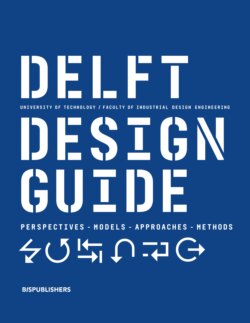Читать книгу Delft Design Guide -Revised edition - Annemiek van Boeijen - Страница 34
На сайте Литреса книга снята с продажи.
ОглавлениеHow? With a More-Than-Human Design approach, you can experiment with ways to access and include the knowledge and behaviour of non-human entities in design work. In doing so, the method contributes to the development of a next generation of co-design methods. Non-human perspectives are the ‘views’ of plants, animals, or intelligent things, namely what they can ‘see’ and contribute to the understanding of a context. Such perspectives are usually included in the design process by means of multispecies ethnography and science and technology studies, and this can be realised with the aid of intelligent cameras, computational or bio-based sensors, and algorithms. It should be noted that this is not about how to see like a pigeon and how to empathise with the pigeon. It is about critically enhancing, complicating,
and possibly challenging human blind spots and biases, specifically at the intersection of the data and trajectories that non-humans give access to and the theoretically informed analysis that humans bring to it.
An example in this guide is the Thing Ethnography approach, which can be applied when designing connected products that can sense data, exchange them, and autonomously act upon the data across decentralised computational networks. The aim of the method is to map the interdependencies of a product ecosystem and its potential societal impact. However, the methods in this guide that are originally developed for human-centred design could be extended to explore and articulate the knowledge and behaviour of animals, plants, and intelligent things as well.
More-Than-Human Design
What & Why? Through design, we are transforming the planet to meet user needs and desires. While it is reasonable to assume a beneficial intent to design, the consequences of design are not always positive and such consequences can range from climate change to resource depletion to surveillance capitalism. A more-than- human perspective acknowledges that humans are more than users: they are part of an ecosystem. Within this ecosystem, it is not exclusively humans who act and produce effects; in fact, plants, animals, and intelligent things can create new possibilities too.
--------------------------------------------------------------------------------------------------------------
Mindset: More-Than-Human Design promotes the idea that to explore the futures we might face, we need to inquire what happens when we step out of an anthropocentric view of the world. Such an inquiry is necessary not because humans matter less but that society has largely become a sphere that threatens inclusion, diversity, and well-being due to the design ideal that humans are users of products to be consumed.
--------------------------------------------------------------------------------------------------------------
References & Further Reading: Clarke, R., Heitlinger, S., Light, A., Forlano, L., Foth, M., & DiSalvo, C., 2019. More-Than-Human Participation: Design for Sustainable Smart City Futures . Interactions26 (3), 60-63. / DiSalvo C., & Lukens, J., 2011. Nonanthropocentrism and the Nonhuman in Design: Possibilities for Designing New Forms of Engagement with and through Technology. In M. Foth, L. Forlano, C. Satchell, & M. Gibbs (Eds.). From Social Butterfly to Engaged Citizen. Cambridge, MA: MIT Press. / Giaccardi, E. & Redström, J., Technology and More-than-Human Design. Design Issues.
Tips & Concerns
The development of a design sensitivity to non-human scales and types of knowledge is a major challenge for designers using a More-Than-Human perspective.
--------
For example, what does it mean to access the knowledge of a river that has existed and has played a role in a specific context for hundreds of years? What are the boundaries of the investigation? How can we map insights in a way that they can be discussed in multidisciplinary teams?
--------
Develop skills for recognising, understanding, and making palpable the potential discom- fort, tension, and compromise that is required to forge new alliances with non-human entities in design. How can animals be enlisted as participants without being harmed? What data can be collected and used with respect to people’s privacy?
---------------------------------------
Limitations
Our understanding is inherently limited by what we humans know regarding the actions and behaviour of living and computational organisms. We can gather a lot from a More-Than- Human perspective, but this kind of consideration concerning the impact of design on the interplay between human and non-human systems is far from trivial.
More-Than-Human Design considers the knowledge and behaviour of non-human entities – from plants to animals to intelligent things – and it aims to craft new capacities for meaning and action at the intersection of humans and non-humans.
perspectives
---------------------------------------------------------------------------------------------------------------------------------------------------------------
33
